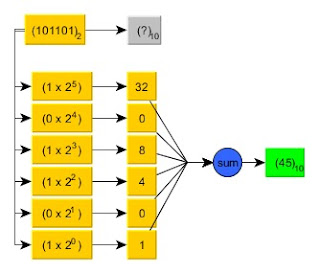Binary to Decimal Conversion and Vice Versa with Illustration and Example
Introduction
Radix is a Latin word for
"root". Root can be considered a synonym for base in the arithmetical
sense. In mathematical numeral systems, the radix or base is the quantity of
one of a kind digits, including zero, used to render to numbers in a positional
numeral system. For instance, in the base-10 or decimal number framework (the
most well-known framework being used today), there is an aggregate of 10 digits
utilized (0,1,2,3,4,5,6,7,8,9), thusly, its radix is 10. In the base-2 or
binary number framework (utilized inside by almost all PCs), there are two
numbers utilized (0, 1), so its radix is two. Different words that are
synonymous with radix are base and root, in a arithmetic sense.
In any standard positional numeral
system, a number is traditionally composed as (x)y with x as the
series of digits and y as its base, in spite of the fact that for base ten the
subscript is normally expected (and discarded, together with the match of enclosures),
as it is the most widely recognized approach to express esteem. For instance,
(100)dec or (100)10 = 100 (in the decimal system) speaks
to the main hundred, while (100)2 (in the binary framework with base
2) speaks to the number four. In addition to decimal and binary, there
are also other numerical systems as shown below
Almost all PCs utilize Base-two or binary
numeral system. The two digits are "0" and "1",
communicated from turns showing OFF and ON separately. Binary system is
utilized as a part of most electric counters. Octal system is also once in a
while utilized as a part of registering. The eight digits are
"0,1,2,3,4,5,6,7" and render to 3 bits (23). Decimal system is the
most utilized system of numbers on the whole world and you generally utilized
as a part of day by day. Its ten digits are "0,1,2,3,4,5,6,7,8,9".
Most mechanical counters utilized by this system. Duodecimal (dozenal) system
is now and again pushed because of detachability by 2, 3, 4 and 6. It was
customarily utilized as a feature of amounts communicated in handfuls and nets.
Hexadecimal system is frequently utilized as a part of figuring as a compacter
portrayal of binary (1 hex digit for every 4 bits). The sixteen digits are
"0,1,2,3,4,5,6,7,8,9" trailed by "A,B,C,D,E,F" or
"a,b,c,d,e,f". Vigesimal is customary numeral system in a few
societies, still utilized by some to count. Sexagesimal system is begun in old
Sumer and go to the Babylonians.[2] Used today as the premise of present day
roundabout facilitate system (degrees, minutes, and seconds) and time
estimating (hours, minutes, and seconds).
Binary to Decimal Conversion
To convert from binary or base 2 to decimal,
take a look the image below.
 |
| Binary to Decimal Conversion Illustration |
Each "one" and a "zero" in
the binary are multiplied by exponentiation operation where its base is 2 and
its base starts from 0 until binary string length minus 1. After that sum every
outcome of the process. And here code implementation in C# through illustration above.
using System;
using System.Collections.Generic;
using System.Linq;
using System.Text;
using System.Threading.Tasks;
namespace BinaryToDecimal
{
class Program
{
static void Main(string[] args)
{
string input = Console.ReadLine();
int sum=0;
for (int i = input.Length - 1 , j=0; i >= 0;i--,j++ )
{
Console.WriteLine(Convert.ToInt32(input[j]) + " * " + Math.Pow(2, i));
Console.WriteLine((int)Char.GetNumericValue(input[j]) + " * "
+ Math.Pow(2, i));
sum += ( (int)Char.GetNumericValue(input[j]) * (int) Math.Pow(2,i) ) ;
}
Console.WriteLine(sum);
Console.ReadLine();
}
}
}
To
extract an integer value from a char do not use "Convert.ToInt32 ()"
because the return of the method is unicode from char of argument. To get the
value of corresponding to char then use method "(int) Char.GetNumericValue
()" like the example above.
Decimal to Binary Conversion
To convert from decimal or base 10 into binary
or base 2, take a look the image below.
 |
| Decimal to Binary Conversion Illustration |
The decimal value is divided into 2, If the value is divisible by 2 then the value 0 if not 1. Take the division value and repeat the division process. This process takes place until the decimal value is 0. Here the code implementation from the illustration above -
int a = Convert.ToInt32(Console.ReadLine());
string binery = "";
int count = 1, max = 1;
int i = 0;
while (true)
{
binery += (a % 2 != 0) ? 1 : 0;
a /= 2;
if (a == 0)
{
break;
}
i++;
}
char[] resultbinery = binery.ToCharArray();
Array.Reverse(resultbinery);
Console.Write("Binery = " );
foreach(char c in resultbinery)
{
Console.Write(c);
}
Console.WriteLine();



Comments
Post a Comment